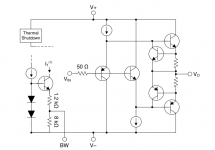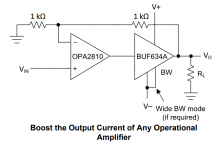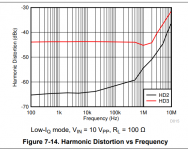Has anyone (recently) ordered BUF634 ICs from China (e. g. Aliexpress, Ebay)? Is there any chance those chips for $2.5-$5 are not fake, while the official price is around $20 per piece in bulk?
A slight possibility they are used pulls otherwise they are probably not real.
OTOH, Mouser sells this one for 5.34$ BUF634AIDRBR
OTOH, Mouser sells this one for 5.34$ BUF634AIDRBR
I didn't see that, thank you! Not the package I would prefer, but it has to be genuine and only 2x the price of Chinese fakes, leaves no reason to gamble.OTOH, Mouser sells this one for 5.34$ BUF634AIDRBR
Less than 2x in quantities I want, even.
And! This is the new and improved 634A. Looks like a steal, actually.
Here's the SOIC version https://www.mouser.ca/ProductDetail/Texas-Instruments/BUF634AIDR?qs=2WXlatMagcEzfspjylVNIQ==
Don't over pay and buy directly from T.I : 2,778 $ a piece.
BUF634A data sheet, product information and support | TI.com
BUF634A data sheet, product information and support | TI.com
That's amazing, I had no idea it was possible! Cheaper than Mouser indeed, and very cheap shipping on top of that.Don't over pay and buy directly from T.I : 2,778 $ a piece.
BUF634A data sheet, product information and support | TI.com
The only thing I'm missing in 634A comparing to the OG 634 is the TO-220 package. I'm not sure SOIC-8 will handle 250 mA of current at +/-18 V swing (even if I stick a small heatsink on top of it).
That's amazing, I had no idea it was possible! Cheaper than Mouser indeed, and very cheap shipping on top of that.
The only thing I'm missing in 634A comparing to the OG 634 is the TO-220 package. I'm not sure SOIC-8 will handle 250 mA of current at +/-18 V swing (even if I stick a small heatsink on top of it).
I didn't know either until I think johnc124 told me here on the forum.
Buying directly from Texas Instruments
According to the pdf above , there shouldn't be that much difference between TO220 , TO263 and a SOIC with thermopad IF you can make a good connection, which isn't that easy. That's why I bought LME49600.😛
https://www.diyaudio.com/forums/members/johnc124.html
The only thing I'm missing in 634A comparing to the OG 634 is the TO-220 package. I'm not sure SOIC-8 will handle 250 mA of current at +/-18 V swing (even if I stick a small heatsink on top of it).
The current is no problem, it's the dissipation (the Watts) that limits it.
Surely you don't want to draw 250mA continuously? If you are driving a DAC, a power amp or a preamp, the average current is a couple of mA and the dissipation is minuscule.
Suppose you set it to 5mA bias current, with +/-18V supply, that's 36 * 5mW or 180mW dissipation. Minuscule.
Then say you on average drive 1V music signal in a 5k load, that's a bit more involved to calculate the dissipation in the chip, but it's 200uA peak output current.
That is a peak dissipation of much less than 36 * 0.2 mW = 7.2mW.
So all in all, less than 0.2W.
Jan
Last edited:
I find this a very odd attitude in general:
So you want a high performance chip but only want to pay very little for it?
Rather pay some for shipping from china and have it transported round the globe.. The planet might suffer a little but who cares.
Best of all: complain afterwards that you received fakes and that china only produces "cheap ****".
Well, its you who asked for it. China is producing "cheap ****" for you. It is you who is cheap.
China isn´t the problem and never was.
So you want a high performance chip but only want to pay very little for it?
Rather pay some for shipping from china and have it transported round the globe.. The planet might suffer a little but who cares.
Best of all: complain afterwards that you received fakes and that china only produces "cheap ****".
Well, its you who asked for it. China is producing "cheap ****" for you. It is you who is cheap.
China isn´t the problem and never was.
Why, of course! As if someone ever wanted to get a low performance chip and pay a lot for it 🙂So you want a high performance chip but only want to pay very little for it?
And I'm not saying China is the problem, I agree with you on that. China is a resource that we can decide to use or not use after weighing risk versus reward.
Thank you for your very useful advice! LME49600 is a great alternative, I'll keep it in mind.That's why I bought LME49600.
You're right, certainly not continuously. And thanks for the calculations. But the application I have in mind is driving loudspeakers by a bunch of parallel buffers.Surely you don't want to draw 250mA continuously? If you are driving a DAC, a power amp or a preamp, the average current is a couple of mA and the dissipation is minuscule.
Thank you for your very useful advice! LME49600 is a great alternative, I'll keep it in mind.
You're right, certainly not continuously. And thanks for the calculations. But the application I have in mind is driving loudspeakers by a bunch of parallel buffers.
Ahhh yes, that changes the situation. But still, music power is way, way less than continuous max power!
You have to decide: design for music, or design for the test bench ;-)
Jan
These two parts have a high THD, upwards of 0.01 and well into the >0.1% range.Have you considered LM675T or OPA549SG3? Seems like a lot easier way to drive speakers.
There's a better power opamp that I know - LT1210, but it's also expensive and not as fun to build a power amplifier with. It's a lot like TDA7293 and similar chips - definitely an easier way, but also boring and well-researched by others.
Haha, yes that way round is the worst case!Why, of course! As if someone ever wanted to get a low performance chip and pay a lot for it
Sorry to put my rant in this thread. It should be quoted in many others. Just get tired sometimes to read the same thing all over again.
I like to think that people who understand electronics must have quite a bit of intelligence in them but apparently not everybody!
Anyways, Buf634 are pretty neat chips if you need higher current. Still have some from old headphone amps in my drawer.
These two parts have a high THD, upwards of 0.01 and well into the >0.1% range.
There's a better power opamp that I know - LT1210, but it's also expensive and not as fun to build a power amplifier with. It's a lot like TDA7293 and similar chips - definitely an easier way, but also boring and well-researched by others.
I would assume that this will be a setup with the high current buffer (which ever it is) inside a feedback loop.
So the buffer distortion is not a deciding factor.
Jan
Interesting, I have not thought of it like that. There will, of course, be a voltage amplifying opamp in front of the BUFs, and there will be global negative feedback from the BUF output to the opamp input.I would assume that this will be a setup with the high current buffer (which ever it is) inside a feedback loop.
So the buffer distortion is not a deciding factor.
Jan
But aren't those THD figures already measured with a feedback loop? I'm pretty sure the published numbers are the best manufacturer could get in a reasonable circuit, I highly doubt those are open loop figures - how do you even set gain without feedback?
Look in the data sheet of the BUF634 - it's an open loop follower, gain 0.99.
These buffers are designed to be used in the loop of another opamp.
For the distortion, you can assume that in the opamp loop it will be 40-60db lower.
In high bandwidth mode it is better.
Data sheets are very interesting 😎
Jan
These buffers are designed to be used in the loop of another opamp.
For the distortion, you can assume that in the opamp loop it will be 40-60db lower.
In high bandwidth mode it is better.
Data sheets are very interesting 😎
Jan
Attachments
Last edited:
- Home
- Design & Build
- Parts
- BUF634 from China?


